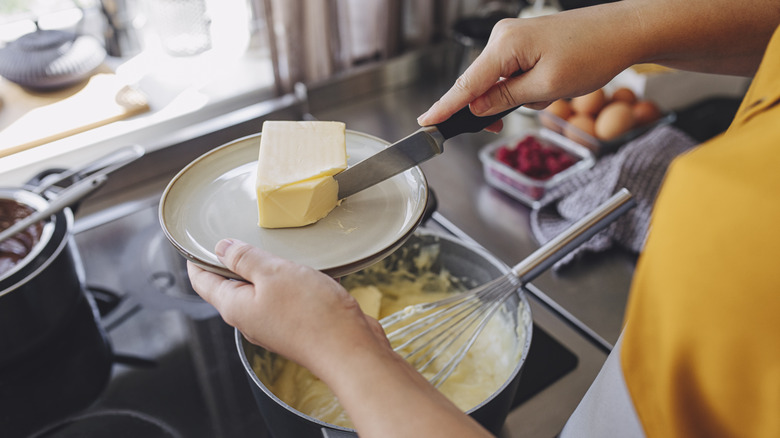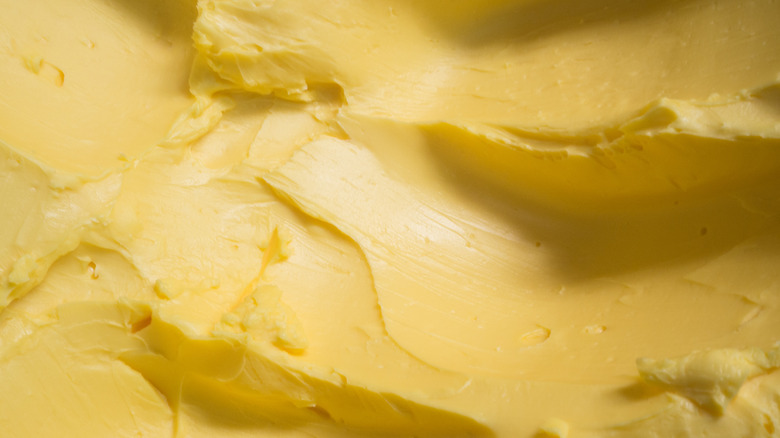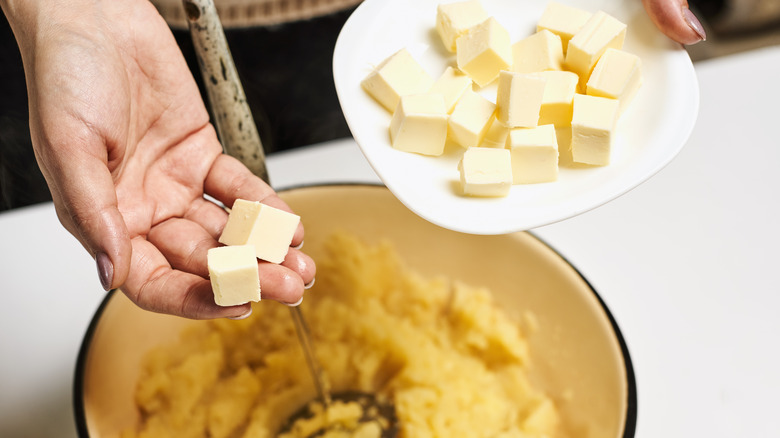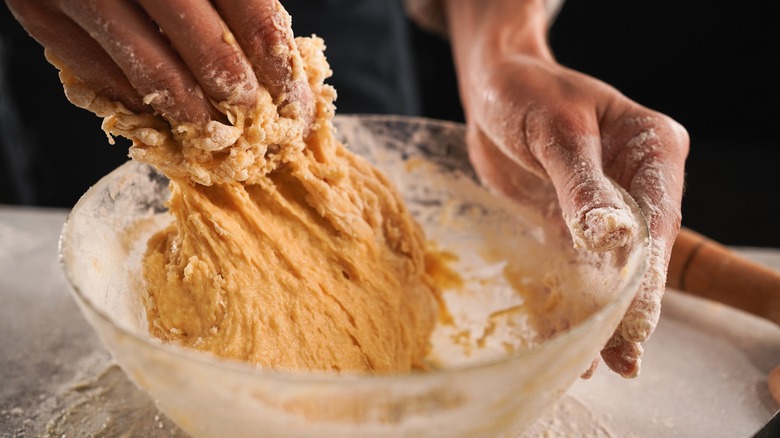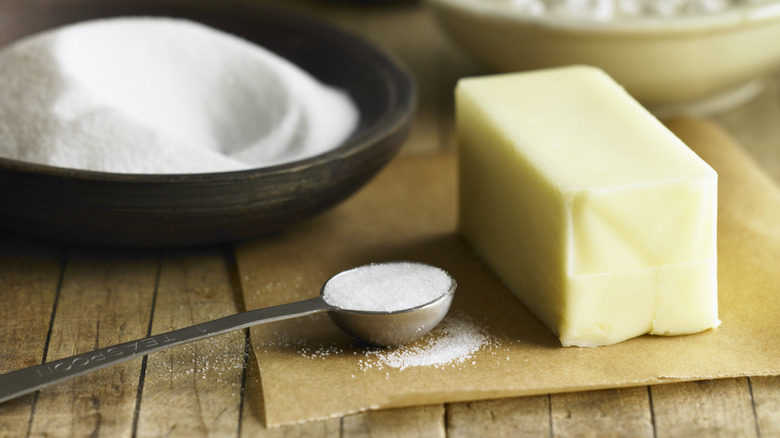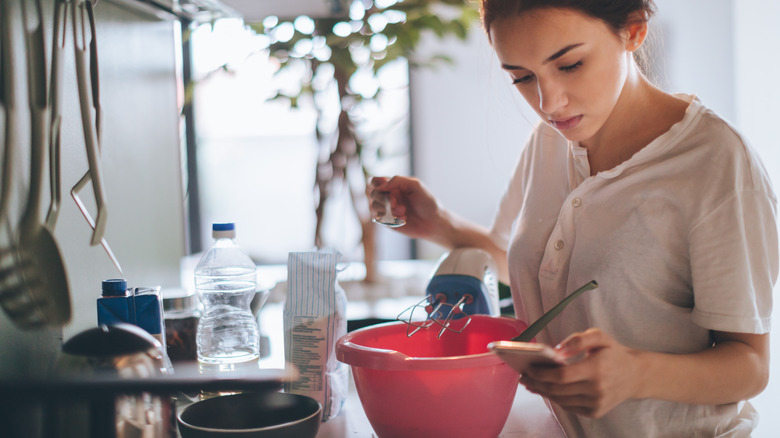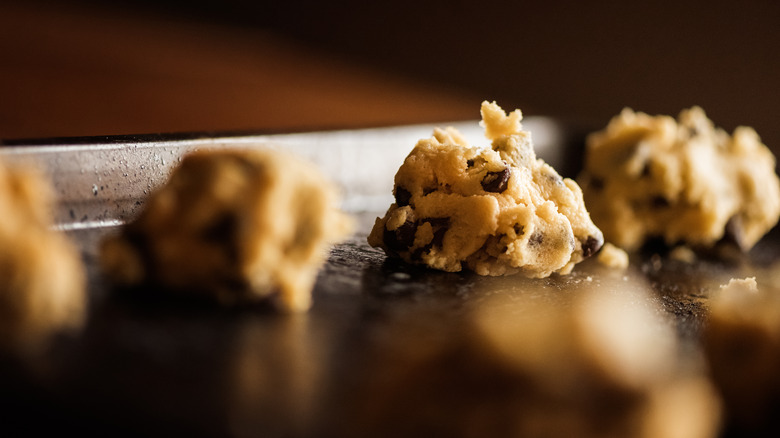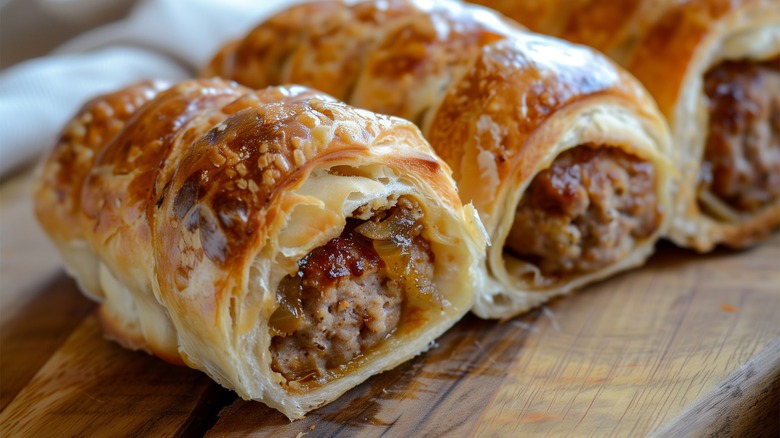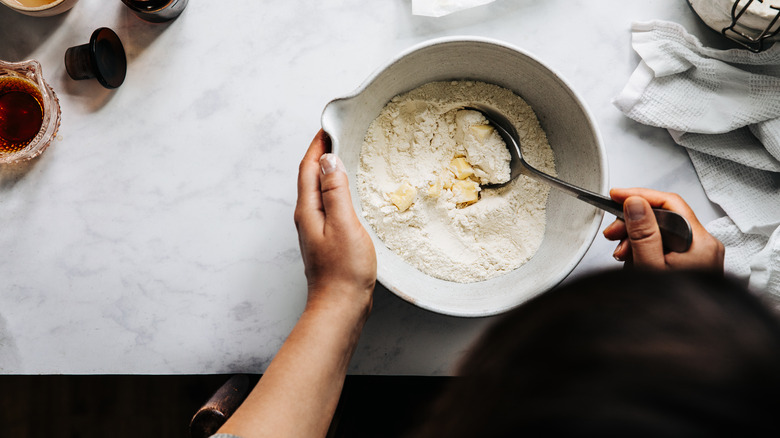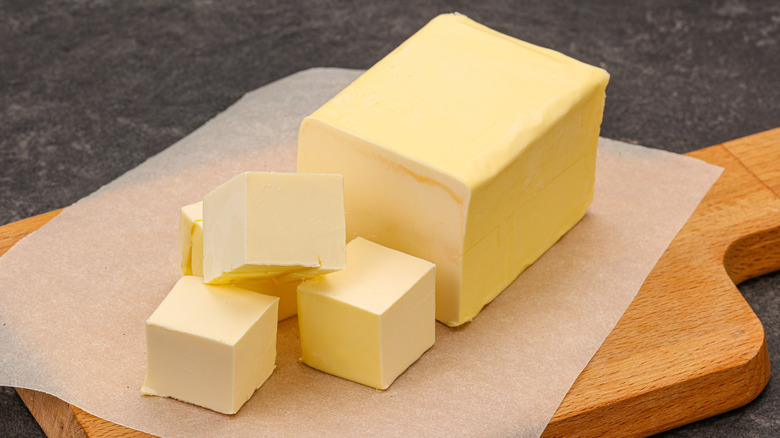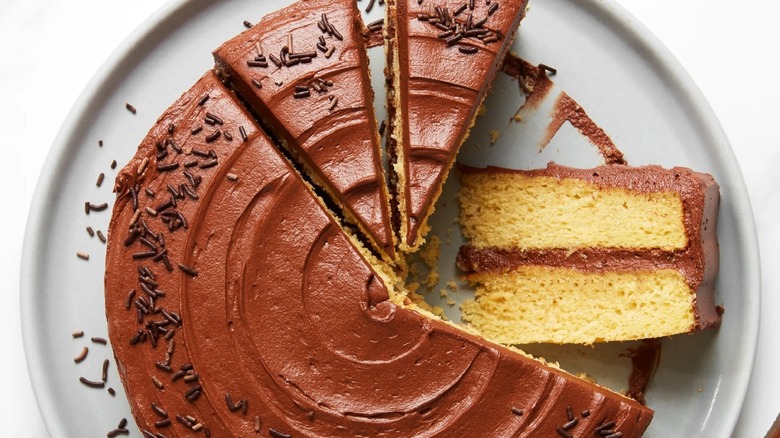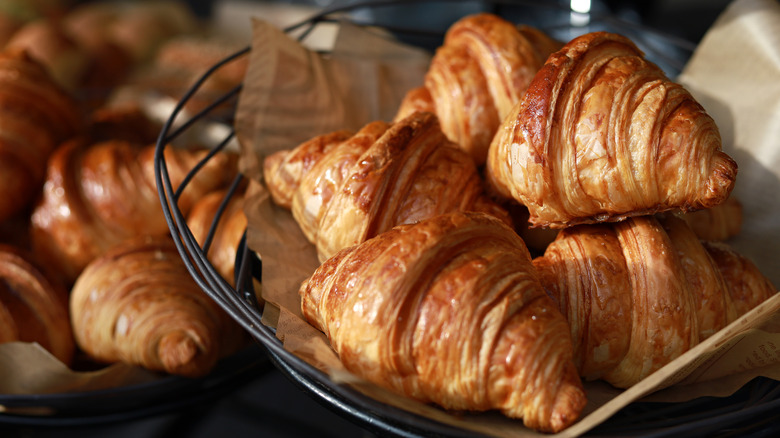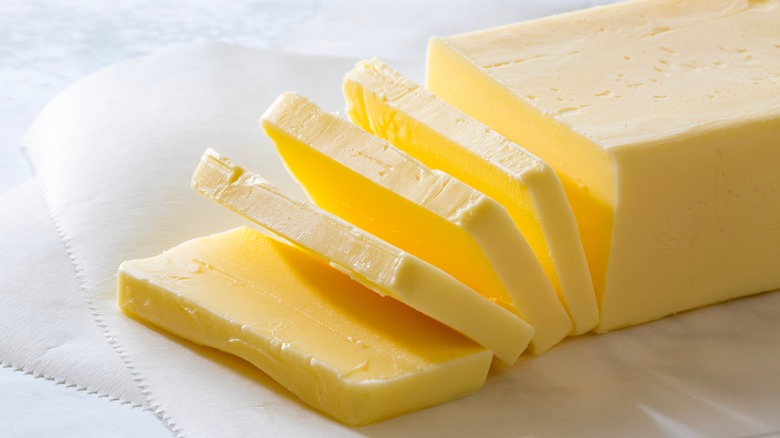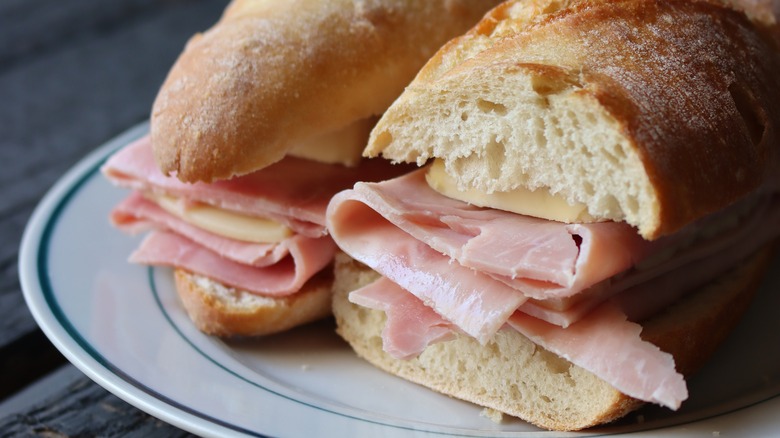A Pastry Chef Shares When To Use Salted Vs Unsalted Butter
If you've ever found yourself double-fisting grocery store butter by the dairy case — one ultra-creamy unsalted, one cultured extra sea salt — and wondering exactly when you're supposed to use salted and unsalted butter, welcome home. You no longer have to live life on the "margarines." Kick back, relax, and let a fabulously talented pastry chef butter you up.
Chef Michelle Palazzo lends her sweet talents to New York City's Frenchette, Le Rock, and the Big Apple's almost 90-year-old bistro, Le Veau d'Or, creating edible works of art like bay laurel cream feuillettes, strawberry gateau, and pistachio and bergamot frangipane galette des rois. Despite her massive chops, chef Palazzo offers easy-to-remember, useful tips and tricks for using salted butter — as well as the unsalted kind — for home bakers of all skill levels.
From the science behind salt and fat in baking, to the methods for maximizing this humble ingredient's potential, chef Palazzo trims the pie crust on how to get the most out of popcorn's best friend. Spread the word, here's exactly when to use salted vs. unsalted butter.
What is salted and unsalted butter?
While you can make your own salted butter, most of us prefer to leave it to the pros. But what is salted butter? How is it made? And which ones are the salty cows? (Just kidding about the cows.) Executive pastry chef Michelle Palazzo weighs in with the answers.
"Simply put, salted butter has salt added to it while unsalted butter does not," she explains. "Salt is usually added to butter right after it has been churned or while it is kneaded to evenly distribute the salt." During industrial butter production, this churning is done in large stainless steel drums that are carefully monitored for proper temperature and pH as a lactic acid reaction turns cream into butter. The salt comes next. However, the amount of salt added to the mix can hit anywhere within a range of 1.6 to 1.7% of total weight, according to the National Dairy Council.
"There is no standard for how much salt is in salted butter, so it can vary from brand to brand," chef Palazzo says. Even so, in most cases, there's no secret salt bomb just waiting to be unwrapped. She clarifies, "It is usually around ¼ teaspoon per ½ cup."
Does salted butter add more flavor to a recipe?
While you'd never go lighter on the salt in baking, you might wonder if you'll get a little extra zip and zing by using salted butter instead of unsalted. Chef Michelle Palazzo notes, "Salt is commonly used to enhance the flavor of foods and can also increase sweet flavors in desserts and pastries, so yes, salted butter will add more flavor than unsalted butter." In the mood for a little more oomph? Bring it on.
But even though salted butter dutifully cranks up the flavor, it shouldn't take the place of good ol' sodium chloride. "Salted butter should never be your only source of salt in a recipe as you should be adding [it] on its own to properly interact with the other ingredients," chef Palazzo says.
Salt does more than just amplify flavor in baking. It also aids in the fermentation process and strengthens gluten, allowing it to stretch. And unlike other palate-tempting seasonings (oh hi, cinnamon), just the right amount of salt allows a food's original flavors to really shine without tasting, well, salty.
Salted butter can ruin your baking and not just because of the salt
Even though salted butter can add flavor to a recipe, it's not always a welcome addition to the mixing bowl. If you're a seasoned baker, you know that exact measurements are key to a great bake (chocolate morsels are exempt from this rule, obviously), but precision is tough to achieve when you don't know how much salt you're actually adding.
"Because the amount of salt varies by brand, it's hard to know exactly how much salt you may be adding to your recipe if using salted butter," pro pastry chef Michelle Palazzo explains. "Baking is a science so to have more control over the recipe we use unsalted butter and then add a prescribed amount of salt later."
Speaking of that A+ chemistry, you'd never think of dumping a bunch of water all over the magic in your mixing bowl. But salted butter can pack a higher water content. That extra water can then affect gluten formation in your baking, leading to dough that's oddly sticky or flat. Want grandma's honey muffins to turn out perfectly puffed and tender? Stick with unsalted butter.
Don't use salted butter as a substitute for salt plus butter in recipes
If you're baking while hangry, tired, or stressed (you're a modern hero for agreeing to a 6 a.m. bake sale), you know you're vulnerable to taking a cheap shortcut. Need cloves, nutmeg, ginger, and cinnamon? Just throw in pumpkin spice. Out of eggs? Swap in soda. But one seemingly innocent cope should never be implemented IRL: Using salted butter instead of salt and butter.
Like liquid soap that tries to be body wash, face wash, and shampoo, salted butter doesn't perform in the same way as salt and butter do. "While you can technically use salted butter for baking if this is all you have on hand, just know that the result may taste different and overly salty than if you were to use unsalted butter," chef Michelle Palazzo warns. [Cough] (Sorry, I just got a little salt caught in the back of my throat.)
But even if you're gung ho on the possible extra-salty flavor, this imprecise measurement can wreak havoc on structure, too. As chef Palazzo notes, "The texture may turn out differently especially if you're working with a high-fat yeast dough because salt can kill the yeast in a bread." Save the salted butter for baked potatoes, not baking panettone.
What to do if a recipe just calls for butter
Maybe this goes back to cookbook author Fanny Farmer who first published "precise" cup-based measurement standards for stateside home cooks, leading American recipe authors to stay plugged into that nostalgic measuring system since 1896. It might be that same sentimentality that influences the ingredients list — especially when it comes to baking recipes that just call for "butter." (A hamster in your prefrontal cortex suddenly perked up.) Does that mean salted or unsalted? What kind of butter is this? What's butter?
"Dessert and pastry recipes will typically call for unsalted butter," chef Michelle Palazzo shares. But even if the butter variety remains unclear, there's a well-worn path to fresh-baked success. She adds, "In a case where it isn't specified what kind of butter to use, I would recommend using unsalted butter."
A quick peek at the other ingredients might offer you even more directional clues. As chef Palazzo explains it, "If you see salt listed as its own ingredient, you can be confident that unsalted butter is the way to go as the recipe author has accounted for the correct amount of salt needed to create the perfect balance of sweetness and flavor."
When salted butter is your greatest baking asset
Okay, this isn't just a "schmear" campaign against salted butter. There are even occasions in which the saltier version of the fat is the best way to go. (I'm not just talking about slapping a pat of butter on a plain toaster pastry.)
"There are many scenarios where salted butter is an asset, specifically when you want to accentuate other flavors in a recipe," executive pastry chef Michelle Palazzo shares, probably not ruling out salt-forward treats like salted butter brioche bread, salted butter chocolate chip cookies, or salted butter caramel-chocolate mousse. (I'm noticing a theme; If there's salted butter involved, you probably won't miss it in the name.)
Still, chef Palazzo confirms that most sweet treats require salt-free butter. "In most baking scenarios, unsalted butter is the assumed ingredient called for in recipes," she says. "I would only recommend using salted butter in sweet applications as a finishing ingredient."
Use unsalted butter for pastry, even for savory recipes
Sometimes the best home bakes involve a decidedly savory recipe. (Pearl onion tarte tatin anyone?) So why not cook with salted butter if the flavor's not supposed to be sweet? In general, it's because you want your savory pastries to turn out just as well as the sugary ones.
Chef Michelle Palazzo explains, "When baking pastries, I always work with unsalted butter. This allows you to control the amount of salt in the recipe and helps to ensure consistent results and the best flavor and texture." Even for the most mouthwatering ham and cheese handpie, you still don't want to overdo it on the salt. And it turns out, that salt content features into the mix with the most foundational elements.
"The amount of salt in your recipe (or your butter) also impacts the dough's moisture levels which is a key element of baking," says chef Palazzo. "When you are working with pastry dough and looking to create a flaky, airy texture in your final product, using a high butterfat butter, like Plugrà European Style Butter with 82% butterfat, and the correct amount of salt is crucial."
What if you only have salted butter in the fridge?
Okay, so the consensus on when to use unsalted over salted butter probably feels like old hat by this point. But is it game over if you're ready to whip up a cake and all you have is salted butter in the fridge? It's not if you strategize for it.
Acknowledging the total bummer-ness of this scenario, executive pastry chef Michelle Palazzo offers some advice, noting, "If salted butter is all you have on hand, I recommend reducing the amount of salt the recipe calls for by about half." Say you're making this chantilly berry cake which calls for ½ cup of unsalted butter and ½ teaspoon of kosher salt. You can easily transition to ½ cup of salted butter by cutting the kosher salt to ¼ teaspoon.
But even though this method offers a quick way to keep your scratch-made dreams afloat, you'll still want to keep a close eye on the amount of salt you're adding. Chef Palazzo says, "It's best to err on the side of caution, as you can always add more salt later, but you can't take it out once it's added."
What happens if you accidentally use salted butter in a recipe?
Terrorizing innocent home bakers and the recipes they love, salted butter has surreptitiously made its way into a mixing bowl or two — unbeknownst to the chef until far too late. What do you do if you accidentally use salted butter in a recipe that calls for unsalted? Welcome to your first buttery therapy session. (Please enjoy a moment of tranquility on the chaise and gently place your oven mitts over your heart.)
"If using salted butter by mistake, normally I would omit any extra salt in the recipe if you catch it in time," says pastry chef Michelle Palazzo. But she also sees and hears those who may have already put the batter through the mixer. She adds, "If it is mixed in already, you can offset it with a bit of acid, lemon juice, or vinegar. You can also add a touch of sugar or honey to balance it out."
Still, even though it feels like a five-alarm fire-type situation, go easy on the dessert-saving adjustments. "Remember just a teaspoon or so as you don't want the sugar or acid to change the structure of your bake," she shares. (Officially declaring chef Palazzo as a national treasure.)
The best style of butter to use for home baking
Once you've narrowed down whether you're using salted or unsalted butter in your baking, you might notice a wide range of options on either side of the aisle. Sweet cream, cultured, European, Irish, or grass-fed, it all comes down to just two elements. "Fat and salt are both key elements to balancing flavor in any recipe, so understanding how they interact will help home bakers create the best result," chef Michellle Palazzo says.
"Butterfat impacts the flavor and texture of your desserts and pastries," she adds. "Most American butters typically only have 80% butterfat whereas European style butters, or those with 82% butterfat or higher, are churned longer to achieve a richer and creamier consistency thanks to a higher fat percentage." In the Unites States, it's not legally butter unless there's a minimum 80% butterfat content, but chef Palazzo suggests going for the higher-quality stuff when it comes to baking. Luckily, most European-style butter brands list the butterfat content plainly on the packaging.
"Pastry and dessert recipes are often developed with 82% butterfat content in mind," she explains. "So ideally, you want to use unsalted European-style butter when baking. My personal choice is Plugrà European Style Butter in the unsalted variety."
What about recipes that call for salt plus salted butter?
If you happen to come across a dessert recipe that calls for salted butter — and also added salt — there's no need to book an emergency butter therapy sesh. Proceed as directed and enjoy the delicious (possibly candied) fruit of your labor.
"Most home bakers use one butter in their home. So a lot of the time recipes that we find online will call for salted butter or won't specify," confirms chef Michelle Palazzo. I shared a classic yellow cake recipe with her that featured 1 cup of salted butter, ½ teaspoon of salt, 1 ½ cups of sugar, and 4 large eggs, among other ingredients. She offers, "In this scenario, I might lower the amount of salt by half since this cake already has a high fat and sugar ratio." While salted butter has been budgeted into this particular recipe, it's still not the preferred butter of choice.
"Any baker, either home or professional, will tell you that you want to be in control of your bake," the pastry chef notes. "Since a lot of recipes use raw product, one can't really taste the batter or dough until fully cooked. Baking is a science, and we want that control to be able to produce a perfect result."
The butter-driven blitz puff method for pastry
I confess to spending countless hours streaming baking shows, carefully studying the different buttery layers between choux and puff pastry. But when it comes to making puff pastry at home, some of us would rather throw in the towel at the second lamination. For anyone searching for a better way, all you have to do is puff, puff, blitz.
"The Blitz Puff method, also known as the Stacking method or lamination, is a way of incorporating butter throughout your dough," explains chef Michelle Palazzo. "We typically use this when working with pastries that are layered and have an airy and flaky texture, like a croissant, but you can also use this with things like pie doughs." Wait, there's pie dough with butter sprinkled throughout the whole crust in light, flaky layers? Where do I sign?
"By stacking the layers of dough on top of themselves, you create layers of butter between the layers of dough," chef Palazzo adds. "As the butter melts in the oven, more steam is produced, resulting in a delicate, flakier, puff-pastry-like texture."
Quick reference guide for using salted vs unsalted butter
The big, beautiful world of butter can feel completely overwhelming if you're desperate for answers in a pinch. So, next time you find yourself wondering whether you should use salted or unsalted butter, think of this:
"As a general rule of thumb, use unsalted butter when baking and salted butter when cooking, creating sauces, or for spreading," says pro pastry chef Michelle Palazzo. Chocolate cake: unsalted; creamy polenta: salted; garlic sauce: salted; and for the multigrain toast you almost burned while you were making your coffee at the same time: salted. There truly is a butter for everything, and now you can proudly say you know which one goes where.
But if you're staring at the ingredients list for a new cookie recipe and still feeling lost as to which butter to use, chef's got your back. She advises, "When in doubt, follow the recipe and assume unsalted if not specified in the recipe."
Chef Palazzo's favorite way to use butter in baking
If anyone knows butter, it's a celebrated New York City-based pastry pro like chef Michelle Palazzo. "Butter is a product that is such a key ingredient in my professional life, so I really use it in so many ways," she shares. As for how she prefers to enjoy it off-duty, she says, "I love high-quality flakey sea-salted butter for finishing sauces or just on my sandwiches. Nothing is better than a salted butter and French ham sandwich."
A diplomatic advocate for both the salted and unsalted butter varieties, she shares a surprising way anyone can incorporate more butter into baking. "For unsalted butter, I really use that for all of my baking ... Cookies, cakes, creams, there are endless possibilities," chef Palazzo says. "One of my favorite ways of using butter is to set a cream. If I want to make a cream have more body, I will immersion blend it with butter to produce a pliable, pipeable texture."
That sounds delicious. (Thank you, chef!) If you're feeling just as hungry as I am right now, satiate the butter monster with a fresh batch of crumbly shortbread cookies, turn a boxed cake ultra-luxe with butter, or create a super creamy icing with canned frosting and — you guessed it — butter!

